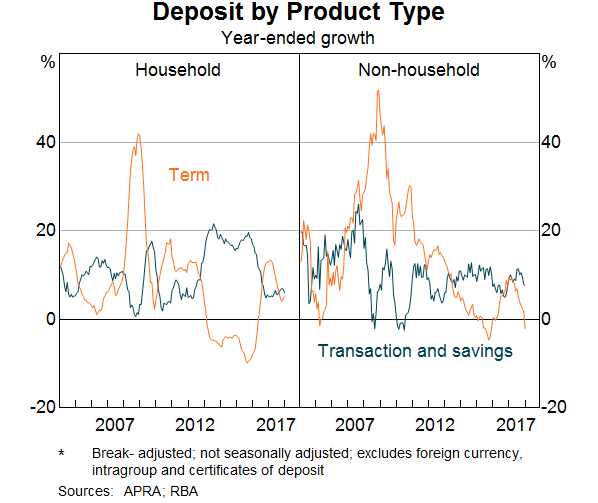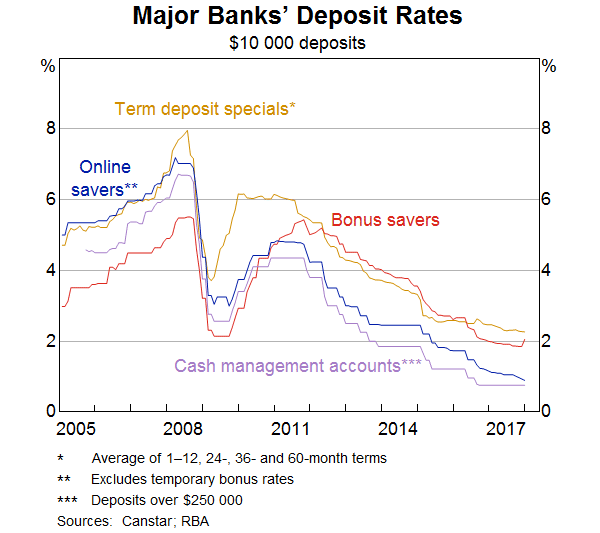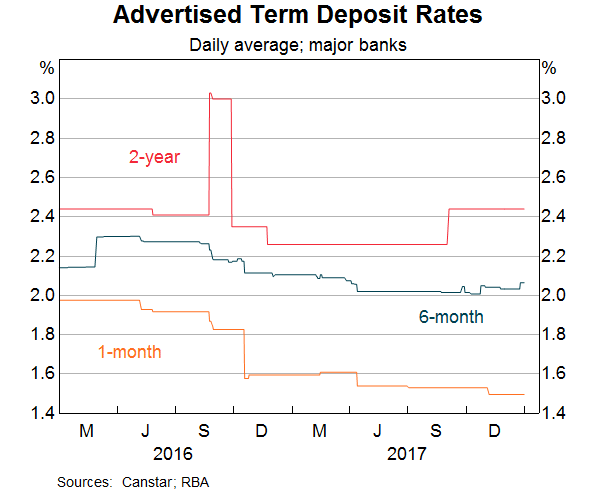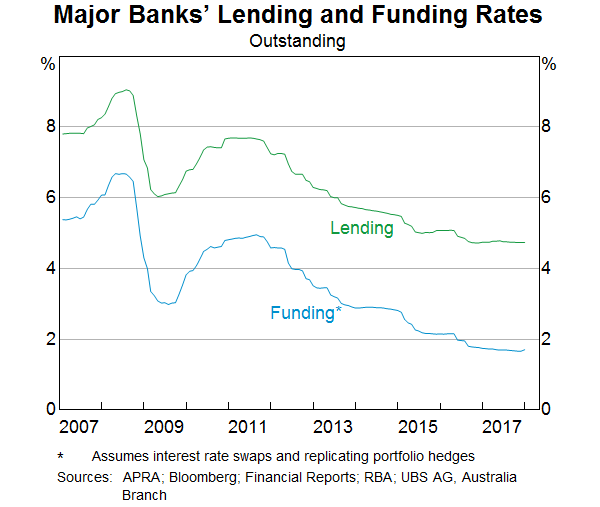Bulletin – March 2018 Finance Developments in Banks' Funding Costs and Lending Rates
- Download 531KB

Abstract
This article updates previous Reserve Bank research on the composition and pricing of banks' debt funding and lending rates. The major banks' debt funding costs declined a little over 2017, primarily driven by a decline in the cost of deposits. Over the same period, overall lending rates were little changed, with higher household lending rates partly offset by lower business lending rates.
Introduction
The rate that banks offer on household and business loans is partly driven by the cost of banks' funding. Banks also take into account the risks inherent in lending, such as the credit risk associated with loans and the liquidity risk involved in funding long-term assets with short-term liabilities. Banks' growth strategies, competition in the financial sector and their desired return to equity holders also affect their lending rates.
An important element in determining the overall cost of banks' funding is the level of the cash rate, which acts as an anchor for the broader interest rate structure in the domestic financial system. Nevertheless, there are other factors that influence funding costs, such as changes in the level of compensation demanded by investors for holding bank debt. The full effect of such changes can take some time to flow through to funding costs and lending rates. In part, this reflects the time that it takes for balance sheet liabilities to be repriced, particularly those with longer terms to maturity. This article updates previous Reserve Bank research and focuses on developments in banks' funding costs and lending rates over 2017 (Cheung 2017).
The cost of banks' debt funding (hereafter ‘funding costs’) has decreased a little over 2017, driven by a decline in the cost of deposits. Deposit costs fell as term deposits that were contracted at relatively high rates in late 2016 were replaced at lower rates. The cost of issuing new debt also decreased over 2017 for both short and long tenors. The effect on outstanding long-term debt costs of the lower cost of issuance over 2017 is estimated to have been partially offset by higher costs from banks continuing to increase the average tenor of their debt and movements in banks' interest rate hedges.
There were a number of changes in banks' lending rates over 2017. However, average lending rates were little changed overall, with the effect of an increase in the rate charged on investor and interest-only housing loans offset by the effect of a decrease in business lending rates. Banks chose to increase investor and interest-only housing loan rates to reduce lending to investors and interest-only borrowers following APRA's macroprudential measures (APRA 2017a).
The spread between banks' funding costs and their average lending rates widened slightly, because lending rates were relatively stable overall and funding costs declined.
Funding Composition
Banks obtain funding from three sources: deposits, wholesale debt and equity. While the funding structure of individual banks can differ from the aggregate, there has been a broad-based shift in the funding composition of all Australian banks since the global financial crisis toward funding sources that are considered more stable, such as deposits from retail customers (Graph 1). This shift in funding was initially driven by a reassessment of risk by banks following the crisis; more recently, however, the increase in stable funding has been due to factors such as lower premia on debt issuance and the introduction of the Net Stable Funding Ratio (NSFR) requirement which came into effect on 1 January 2018 (Brown et al 2010; Cheung 2017; APRA 2016).[1]

Deposits
Since the global financial crisis there has been a shift toward domestic deposit funding which has been most pronounced for smaller Australian-owned banks. The share of funding sourced from domestic deposits has more than doubled for these institutions, while the share of funding sourced from securitisations and short-term wholesale debt has declined markedly. The smaller Australian-owned banks' domestic deposit share of funding has risen further in recent years, whereas this share has been broadly stable for the major banks and foreign banks operating in Australia.
For the five years following the global financial crisis, term deposits were the fastest growing deposit product (Graph 2). From 2013, however, transaction and savings deposits grew strongly, as banks decreased the price of term deposits by more than some savings deposits. In late 2016, competition for term deposits increased, reflecting the fact that they are considered to be a more stable source of funding under the NSFR regulations. More recently, growth in term deposits has slowed as banks lowered the rates on these products, consistent with an expectation that they would remain comfortably above the regulatory minimum for the NSFR.

Wholesale funding
The major banks obtain a larger share of funding from offshore wholesale markets compared with other Australian-owned banks (Graph 3; Graph 4). Recently, these smaller Australian-owned banks have further reduced their use of domestic short-term debt and funding from offshore debt markets as they have shifted toward more deposit funding. Changes in the composition of banks' funding can affect their overall funding costs as long-term debt is typically more costly than short-term debt and deposits.


The share of funding sourced from securitisation has declined for all Australian banks since the financial crisis. However, higher issuance of residential mortgage-backed securities (RMBS) in 2017 has helped to stabilise securitisation as a share of total funding, at around 1 per cent. Over 2017, there was a notable increase in RMBS issuance by a number of smaller Australian-owned banks. This increase in issuance is consistent with improved conditions for issuing RMBS: primary market pricing declined over the second half of 2016 and remained broadly stable at this lower level throughout 2017 and there was reportedly an increase in foreign demand for some highly rated RMBS tranches.
Foreign banks operating in Australia obtain a substantially larger share of their funding from short-term debt compared to Australian-owned banks. Around 60 per cent of this short-term debt is funding from their offshore head office; they raise the remainder from short-term debt markets. The foreign banks' share of short-term debt funding has declined since the global financial crisis, offset by an increase in the share of funding sourced from domestic deposits.
Equity
The share of bank funding from equity has been stable over recent years across all institution types. Since mid 2015, banks have increased their stock of equity funding by around $30 billion, largely in response to changes in prudential regulations that have increased the average mortgage risk weights; this growth in equity has been broadly in line with growth of other forms of funding. In July, APRA announced increased requirements to Common Equity Tier 1 (CET1); it is expected that Authorised Deposit Taking Institutions meet these requirements by 2021 (APRA 2017b). The major banks indicated in recent profit reports that they are on track to meet these capital benchmarks and should be able to generate this additional capital by retaining profits, without significantly altering their business growth plans or dividend polices, and without undertaking further equity raisings.
Funding Costs
Overall funding costs for the major banks are estimated to have declined by around 4 basis points over 2017, largely reflecting lower deposit costs and some compositional shifts between different deposits (Graph 5).

Deposits
The decrease in the cost of deposits over 2017 has been driven in part by a decline in the average cost of term deposits, as term deposits that were contracted at higher rates in late 2016 have since been replaced with term deposits at lower rates. There was also a decrease in the advertised interest rates on some at-call savings accounts, such as online and bonus savings accounts (Graph 6). In addition, there was a change in the mix of deposits toward retail transaction and savings deposits, which contributed a little to the decline in the cost of deposits since these types of deposits typically have relatively low interest rates.

Banks continue to offer higher rates on longer maturity term deposits, as these types of deposits are considered more stable under the NSFR (Graph 7). Even so, the interest rates on these deposits have only a minimal effect on total funding costs as they represent a small share of total deposits.

Wholesale funding
Conditions for issuance in wholesale funding markets were favourable throughout 2017, with the cost of issuing new long- and short-term debt both declining. Nevertheless, net bank bond issuance was a little lower in 2017 than in 2016, which was a particularly strong year for issuance [ahead of the introduction of the NSFR in January 2018] (Graph 8). The lower issuance of wholesale debt by the major banks over the past year occurred alongside slower growth in bank assets and stronger growth in deposits.

The cost of banks' outstanding wholesale funding decreased slightly over 2017, owing to a decline in short-term wholesale funding rates and the maturing and refinancing of long-term debt at lower interest rates. It is estimated that a decrease in the cost of outstanding wholesale funding was offset by higher costs due to changes in interest rate hedges over 2017. The cost of new long-term debt issuance was below the cost of outstanding debt for most of 2017, with bank bond spreads around their lowest levels in 10 years (Graph 9; Graph 10).


Working in the opposite direction, the banks have lengthened the average tenor of their debt over recent years, consistent with the incentives provided by liquidity regulations and also lower premia than in the past. Since 2010, the average tenor of banks' debt has increased from around 5 to 7 years (Graph 11). As issuance at a longer tenor is typically more expensive, the increase in the overall tenor of debt has added a little to the major banks' funding costs.

Lending Rates
The average outstanding interest rate on mortgages increased over 2017 as a result of the way in which banks chose to respond to APRA's macroprudential measures, which included a requirement to limit interest-only approvals to 30 per cent of total new residential mortgage lending. The banks decided to raise interest rates for both new and existing interest-only loans and investor loans more generally (RBA 2017).

Business lending rates generally declined over 2017, with the average outstanding interest rate on large business loans falling by more than the decline for small business loans (Graph 12). One reason for these declines is strong competition in this lending market, especially by foreign-owned banks.
Banks' Implied Spreads
The implied spread is the difference between estimates of average lending rates and average debt funding costs. This measure differs from some commonly reported measures of bank profitability as it excludes the effects of non-loan interest earning assets, such as cash and liquid assets. The implied spread is estimated to have increased over 2017 for both major banks and smaller Australian-owned banks (Graph 13).
The increase in the measure of spreads was mainly driven by lower debt funding costs, with higher household lending rates partly offset by lower business lending rates. The implied spread for some smaller Australian-owned banks increased by slightly more than for the major banks. This was partly driven by an increase in foreign bank competition for business loans, contributing to lower business interest rates, which are a larger share of the lending undertaken by the major banks.

Footnotes
The author is from Domestic Markets Department. [*]
The NSFR requires banks to maintain a stable funding profile in relation to the composition of their assets and off-balance sheet activities. In their most recent profit reports, the major banks have reported that their NSFRs are above the 100 per cent regulatory minimum. [1]
References
APRA (Australian Prudential Regulation Authority) (2016), ‘Prudential Standard APS 210: Liquidity’. Available at <http://www.apra.gov.au/adi/PrudentialFramework/Documents/APS%20210%20FINAL.pdf>.
APRA (2017a),‘APRA announces further measures to reinforce sound residential mortgage lending practices’, 31 March. Available at <http://www.apra.gov.au/MediaReleases/Pages/17_11.aspx>.
APRA (2017b), ‘APRA announces "unquestionably strong" capital benchmarks’, 19 July. Available at <http://www.apra.gov.au/MediaReleases/Pages/17_23.aspx>.
Brown.A, Davies.M, Fabbro.D, Hanrick.T. (2010) ‘Recent Developments in Banks' Funding Costs and Lending Rates’, RBA Bulletin, March, pp 35-44.
Cheung (2017), ‘Developments in Banks' Funding Costs and Lending Rates’, RBA Bulletin, March, pp 45-50.
RBA (2017), ‘Competition in the Financial System’, Submission to the Productivity Commission Inquiry, September.